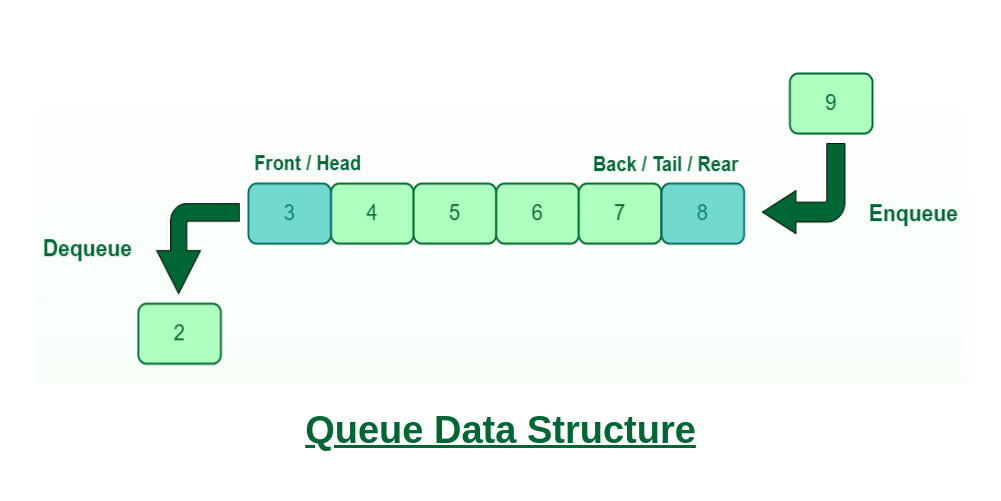【数据结构与算法】
发布时间: 2024-09-12 10:07:21 阅读量: 84 订阅数: 71 


# 1. 数据结构与算法概述
在计算机科学和编程领域中,数据结构和算法是基础且核心的内容。本章将为读者提供这两个概念的全面概览,为后续章节中对具体数据结构和算法的深入分析打下坚实基础。
## 数据结构与算法的定义
数据结构是一门研究组织、存储、管理和检索数据的学科,它涉及数据的逻辑结构、物理存储结构以及这些数据结构上的操作算法。而算法则是解决特定问题的一系列定义良好的步骤。
## 数据结构与算法的重要性
它们对于开发高效和优化的软件至关重要。通过合理选择和实现数据结构,可以在信息检索、资源管理和数据操作方面提高程序的性能。掌握算法则可以优化解决问题的方法,降低资源消耗,提高计算效率。
## 学习数据结构与算法的目标
学习数据结构和算法不仅能够提高编程能力,还能培养良好的逻辑思维和抽象建模能力。这些技能对于准备技术面试、开发复杂的软件系统、以及为未来可能面对的新技术挑战做好准备都具有重要意义。
# 2. 核心数据结构分析
## 2.1 线性结构
线性结构是数据结构中最简单的一种类型,其元素之间存在一对一的关系,即除了第一个和最后一个元素之外,其它数据元素都是首尾相接的。在这一节中,我们将深入探讨数组和链表、栈和队列的基本概念、应用以及它们的操作原理和实现方法。
### 2.1.1 数组和链表的基本概念与应用
数组和链表是最常见的两种线性结构,它们在内存中的存储方式和操作方法各有千秋。数组是一种线性表数据结构,它用一段连续的内存空间来存储一组相同类型的数据。链表是一种物理存储单元上非连续、非顺序的存储结构,数据元素的逻辑顺序是通过链表中的指针链接次序实现的。
数组适合用于读多写少的场景,因为它允许通过索引直接访问任何位置的元素,时间复杂度为O(1)。在随机访问频繁的场景中,数组可以提供良好的性能。然而,数组的大小在初始化后是固定的,且插入和删除操作需要移动大量元素,因此不太适合频繁增减元素的场景。
链表由于其节点之间的链接关系,允许在任何位置进行插入和删除操作,时间复杂度为O(1),但其缺点是不能通过索引直接访问元素,需要从头节点开始遍历,所以时间复杂度为O(n)。链表非常灵活,适合用于写多读少的场景。
在实际应用中,数组常用于实现各种缓存策略,而链表则广泛用于实现数据的动态存储管理和复杂链表结构,如双向链表和循环链表。
```c
// 示例:链表节点的定义
struct Node {
int data;
struct Node* next;
};
// 示例:数组的定义
#define MAX_SIZE 10
int array[MAX_SIZE];
```
以上代码分别展示了如何定义一个简单的链表节点和数组。在定义数组时,可以指定其最大容量,而链表的大小则是动态的,可根据需要随时添加新节点。
### 2.1.2 栈和队列的操作原理及实现
栈和队列是特殊的线性表,它们的元素插入和删除操作只限定在表的某一端,这使得它们具有“后进先出(LIFO)”和“先进先出(FIFO)”的特点。
栈(Stack)是一种后进先出的数据结构,只能在一端进行插入和删除操作。它的操作可以类比为一摞盘子,最后放上去的盘子必须是最先拿下来的。栈的操作通常包括压栈(push)、弹栈(pop)、查看栈顶元素(peek)等。
队列(Queue)是一种先进先出的数据结构,只允许在一端添加元素(入队),而在另一端删除元素(出队)。队列的操作可以类比为排队买票,先进来的顾客先接受服务。队列的主要操作包括入队(enqueue)、出队(dequeue)、查看队首元素(front)等。
```c
// 示例:栈的简单实现
#include <stdio.h>
#include <stdlib.h>
#include <stdbool.h>
#define MAX_SIZE 10
typedef struct Stack {
int top;
int data[MAX_SIZE];
} Stack;
bool push(Stack *s, int x) {
if (s->top == MAX_SIZE - 1)
return false;
s->top++;
s->data[s->top] = x;
return true;
}
bool pop(Stack *s, int *x) {
if (s->top == -1)
return false;
*x = s->data[s->top];
s->top--;
return true;
}
// 示例:队列的简单实现
#include <stdio.h>
#include <stdlib.h>
#include <stdbool.h>
#define MAX_SIZE 10
typedef struct Queue {
int front;
int rear;
int data[MAX_SIZE];
} Queue;
bool enqueue(Queue *q, int x) {
if ((q->rear + 1) % MAX_SIZE == q->front)
return false;
q->data[q->rear] = x;
q->rear = (q->rear + 1) % MAX_SIZE;
return true;
}
bool dequeue(Queue *q, int *x) {
if (q->front == q->rear)
return false;
*x = q->data[q->front];
q->front = (q->front + 1) % MAX_SIZE;
return true;
}
```
以上代码实现了栈和队列的基本操作,包括插入、删除和查看顶部或队首元素。在栈的操作中,使用了一个名为top的变量来追踪栈顶的位置。而在队列的操作中,使用了两个变量front和rear来追踪队首和队尾的位置。通过模运算实现循环队列,避免在队列为空时进行无效的访问。
通过本节的介绍,我们了解了线性结构的基本概念及其应用,并通过代码实例展示了如何实现数组、链表、栈和队列等常见线性结构。在下一节中,我们将继续探讨树形结构的遍历与操作,以及堆与优先队列的管理方法。
# 3. 经典排序与搜索算法
## 3.1 排序算法详述
### 3.1.1 冒泡、选择、插入排序的原理与实现
冒泡排序、选择排序、插入排序是最基础的三种排序算法,通常在算法学习的初期就被介绍。尽管它们在实际应用中效率不是最高,但在理解排序的基本概念和原理方面起着重要的作用。
#### 冒泡排序
冒泡排序是一种简单直观的排序算法。它重复地走访过要排序的数列,一次比较两个元素,如果它们的顺序错误就把它们交换过来。走访数列的工作是重复地进行直到没有再需要交换,也就是说该数列已经排序完成。这个算法的名字由来是因为越小(或越大)的元素会经过交换慢慢“浮”到数列的顶端。
```python
def bubble_sort(arr):
n = len(arr)
for i in range(n):
for j in range(0, n-i-1):
if arr[j] > arr[j+1]:
arr[j], arr[j+1] = arr[j+1], arr[j]
example_array = [64, 34, 25, 12, 22, 11, 90]
bubble_sort(example_array)
print(example_array)
```
在上述代码中,我们使用了一个双层循环,外层循环控制遍历次数,内层循环负责每轮的比较和交换。冒泡排序的时间复杂度为O(n^2),并且它是一种稳定的排序算法。
#### 选择排序
选择排序是一种原址比较排序算法。它的工作原理是:首先在未排序序列中找到最小(或最大)元素,存放到排序序列的起始位置,然后,再从剩余未排序元素中继续寻找最小(或最大)元素,然后放到已排序序列的末尾。以此类推,直到所有元素均排序完毕。
```python
def selection_sort(arr):
n = len(arr)
for i in range(n):
min_idx = i
for j in range(i+1, n):
if arr[j] < arr[min_idx]:
min_idx = j
arr[i], arr[min_idx] = arr[min_idx], arr[i]
example_array = [64, 25, 12, 22, 11]
selection_sort(example_array)
print(example_array)
```
选择排序同样具有O(n^2)的时间复杂度,但它是不稳定排序。它的优点是,只需要极少数的交换次数,且它不需要像冒泡排序一样在每轮结束后都做大量的元素交换。
#### 插入排序
插入排序的工作方式像玩扑克牌时整理牌的动作,即从头到尾进行遍历,将每个元素插入到已排序序列的适当位置。如果当前元素比前一个元素小,则交换它们,继续向前插入;如果当前元素比前一个元素大,则停止交换,因为已排序序列是有序的。
```python
def insertion_sort(arr):
for i in range(1, len(arr)):
key = arr[i]
j = i-1
while j >=0 and key < arr[j]:
arr[j+1] = arr[j]
j -= 1
arr[j+1] = key
example_array = [12, 11, 13, 5, 6]
insertion_sort(example_array)
print(example_array)
```
插入排序也是稳定的排序算法,其时间复杂度为O(n^2),在最坏的情况下也是这样。尽管插入排序效率不高,但当输入数据接近已排序状态时,它将非常有效。
### 3.1.2 快速排序与归并排序的优化策略
快速排序和归并排序是两种更高效的排序算法,它们的平均时间复杂度为O(n log n),在实际应用中比前述冒泡、选择、插入排序要常用。
#### 快速排序
快速排序的基本思想是选择一个元素作为“基准”(pivot),重新排列数组,使得所有比基准小的元素摆放在基准前面,所有比基准大的元素摆放在基准后面(相同的数可以到任一边)。在这个分区退出之后,该基准就处于数组的中间位置。这个称为分区(partition)操作。递归地(recursive)把小于基准值元素的子数列和大于基准值元素的子数列排序。
```python
def quick_sort(arr):
if len(arr) <= 1:
return arr
pivot = arr[len(arr) // 2]
left = [x for x in arr if x < pivot]
middle = [x for x in arr if x == pivot]
right = [x for x in arr if x > pivot]
return quick_sort(left) + middle + quick_sort(right)
example_array = [3, 6, 8, 10, 1, 2, 1]
print(quick_sort(example_array))
```
快速排序在最好情况下时间复杂度为O(n log n),但由于分区操作的性能对于快速排序的效率至关重要,因此其最坏情况下的时间复杂度为O(n^2)。实际应用中,可以通过随机选择基准或使用三数取中法等策略优化其性能。
#### 归并排序
归并排序是建立在归并操作上的一种有效的排序算法,该算法是采用分治法(Divide and Conquer)的一个非常典型的应用。归并排序是一种稳定的排序方法,和选择排序一样,归并排序的性能不受输入数据的影响,但表现比选择排序好的多,因为归并排序时间复杂度是O(n log n)。
```python
def merge_sort(arr):
if len(arr) > 1:
mid = len(arr) // 2
L = arr[:mid]
R = arr[mid:]
merge_sort(L)
merge_sort(R)
i = j = k = 0
while i < len(L) and j < len(R):
if L[i] < R[j]:
arr[k] = L[i]
i += 1
else:
arr[k] = R[j]
j += 1
k += 1
while i < len(L):
arr[k] = L[i]
i += 1
k += 1
while j < len(R):
arr[k] = R[j]
j += 1
```
0
0





